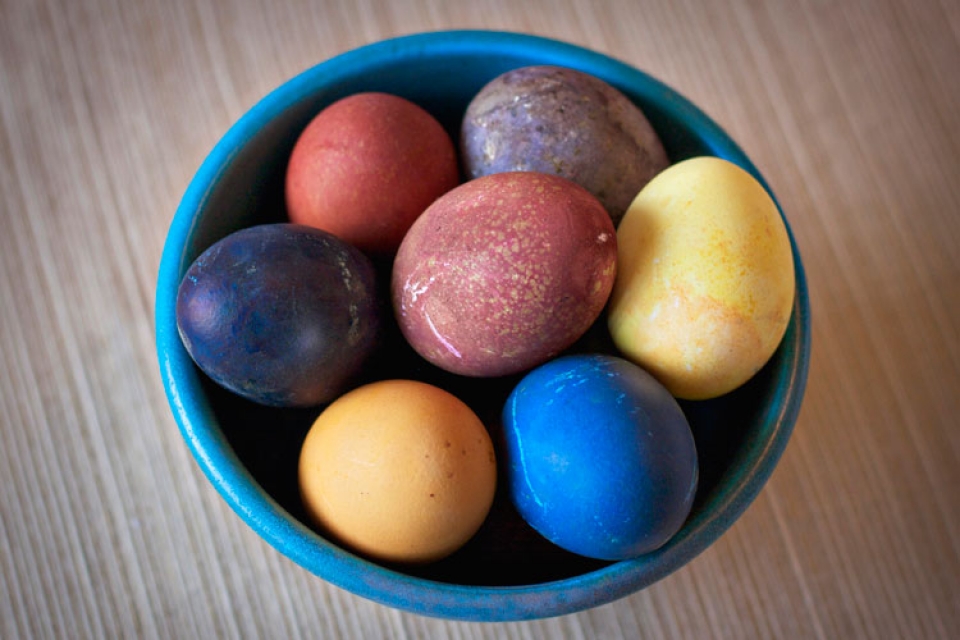Dyeing Eggs Without the Mysterious Fizzy Tablet
If you’re looking to color eggs this spring without using those mysterious fizzy dye tablets made in China, look no further than your refrigerator.
Surprisingly, natural dyes using the colorful spices and vegetables we’ve all got in our kitchens already, can be just as vibrant and fun as the chemical dyes. Here’s how:
Tips for Using Natural Dyes
(1) Start with boiled eggs, or eggs that have been blown out by making a ¼-inch hole in the top and bottom and blowing the yolk and whites into a bowl (refrigerate and use for scrambled eggs or other recipes).
(2) Prepare dyes: Some of these materials work best when they are boiled in some water to draw out the colors, and some work well straight.
(3) Dip eggs in dyes for a few minutes or up to 30 minutes, depending on how intense you want the color to be. The longer you let the eggs soak, the more intense the colors will be. Turn the eggs over occasionally with a spoon. You can use also your favorite egg-dying tricks here as well: Color with crayons for a batik effect or cover with rubber bands for a tie-dye effect. Or, wrap the eggs with onion skins and then in cheesecloth for a marble effect. If you like glossy eggs, you can rub the dyed eggs with vegetable oil when they are dry.
Be sure to eat hard-boiled eggs within 2 hours of cooking, or store in the refrigerator for up to 1 week.
Can You Dye Brown or Blue Eggs?
Yes! We’ve tried out both natural dyes and artificial dyes on brown and blue eggs and they both work well.
Blue eggs look best when they’re dyed in blue, yellow or green colors.
Brown eggs look best when they’re dyed in red, orange or pink colors. We’ve found these eggs will have a rich, earthy undertone color which is beautiful.
Color Ideas
|
Color |
Colorant to Use |
Directions |
Hints |
|
Red/Pink |
Red beets |
Put 2-4 tbsp. freshly grated beets in heat safe cup. Fill 2/3 with boiling water. Add 1 tsp. white vinegar. |
Speckled design. Dye may be strained before use. Orange beets may be used to obtain saffron color. |
|
Orange |
Yellow onion skins |
Use 1 large handful of onion skin for each cup of water. Simmer 20 minutes then add 1 tsp. of white vinegar. |
A perennial favorite. |
|
Yellow |
Turmeric powder |
Put 1-2 tsp. ground turmeric powder in heat proof cup. Fill 2/3 full with boiling water. Add 1 tsp. white vinegar. |
Works quickly. Turmeric stains so be careful. Wipe dusty spice residue from eggs. |
|
Green |
Red cabbage & turmeric |
Pour scant tsp. of turmeric and 2-3 tbsp. of chopped red cabbage in a heat safe cup then add boiling water. |
Speckled design. Wipe vegetable off with damp cloth. |
|
Blue |
Red cabbage |
Put 2-3 Tbsp. chopped red cabbage in heat safe cup. Add boiling water. Add 1 tsp. white vinegar. |
Let sit overnight. Avoid excess handling. |
|
Blue |
Grape juice |
Add 1 cup frozen juice concentrate to 1 tsp. vinegar. |
Eggs may be simmered right in the juice to cook. |
|
Purple |
Red cabbage & beet |
Put 2 tbsp. grated beet and 2 tbsp. red cabbage in heat safe cup. Add boiling water. |
Striking and intense. |
Source: www.lakewinds.com
When you are ready to display the eggs before you eat them, gather twigs and leaves and herbs from the garden to make a nest for the eggs. You can hang blown-out eggs on a few branches of forsythia or pussy willow by attaching a thread to half of a match-stick and inserting it in one hole of the egg.
